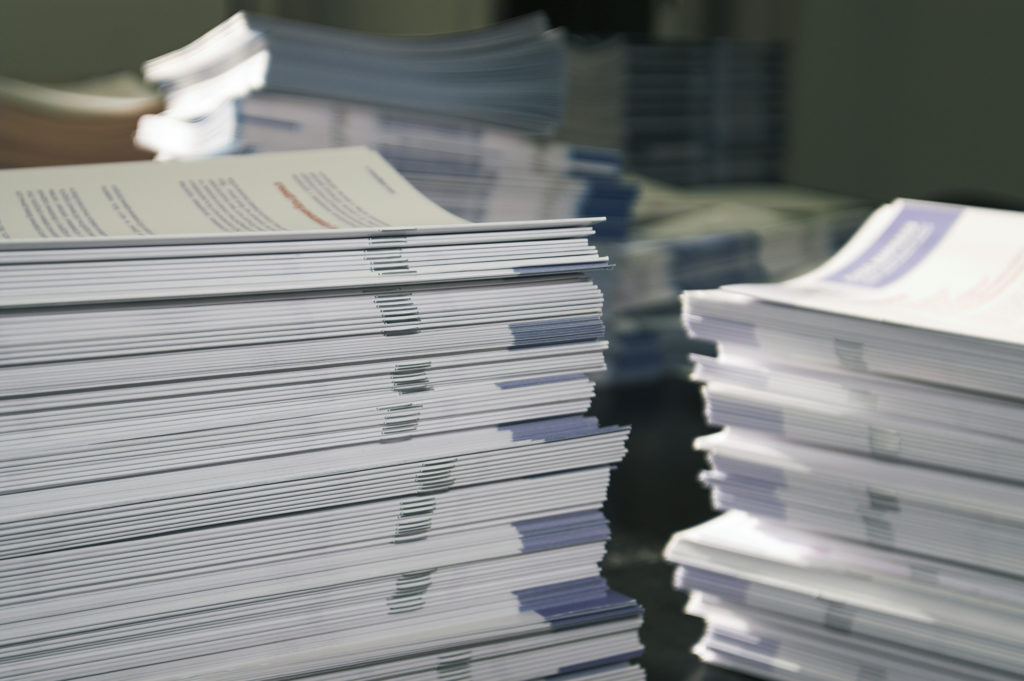5 Most Popular Printed Marketing Materials
Printed marketing materials aren’t dead. And while we’re on the topic, they aren’t old fashioned, moth-eaten relics either. They remain among the most effective marketing materials out there. How effective are we talking? Direct mail boasts response rates of 10 to 30 times that of comparable digital content such as email blasts.
When it comes to printed marketing materials, it’s time to give them a second chance. Read on to learn more about printed marketing collateral and how it could revitalize your marketing efforts.
Printed Marketing Collateral
Print marketing materials remain extremely effective, sometimes more so than digital alternatives. Consumers report feeling overwhelmed by unsolicited marketing emails and other digital content. These messages fill their inboxes, making them less receptive to digital marketing. It’s little wonder, then, that these same consumers prove receptive to direct mail delivered via a much less saturated channel.
Which types of printed marketing materials are most effective when it comes to lead generation and conversions? Let’s take a look at our top five favorite pieces of print collateral:
1. Brochures
Like all print media, brochures have serious staying power. What’s more, your sales team will thank you for printing them. They give people something to hold onto thereby keeping your products and services top of mind.
2. Infographics
While sharing infographics online is all the rage right now, don’t stop there. When printed out, infographics can prove attractive and highly engaging. You can use them as posters or pass them out to prospects after big sales pitches.
3. Business Cards
While some forms of printed materials have declined in use in recent years, business cards remain strong contenders. They’re great for networking and exchanging information, and you’ve got more design options now than ever before.
4. Instructions
Printed instructions still prove much easier for people to use. You don’t have to worry about scrolling down a tablet or other electronic device and having to constantly unlock your screen. Plus, you keep your hands free for the task at hand.
5. One-sheeters
Unlike a brochure, which includes an overview of what your company does, a one-sheeter focuses on one service or product that you offer. That said, a one-sheet still proves as useful to your sales team as a brochure. Learn more about how to improve your visuals and ramp up your sales.
Print and Marketing: A Beautiful Friendship
Despite the digital age, print materials remain an ingrained part of the human experience. We’ve been writing and printing on paper for millennia, and reading from the page remains a satisfying, tactile experience. It’s also one with staying power. That’s why many people still choose books and magazines over Kindles and Nooks. It’s also why people continue to take notes by hand in meetings and pass out handouts during presentations.
While today’s average American sees millions of things every day on their screens, they deal with far less printed collateral. As a result, a brochure or handout that customers can hold “feels” more valuable and special.

Why You Need Printed Marketing Materials
Printed marketing materials show those around you that you’ve gone the extra mile when it comes to creating a lasting impression. You’ve put in the time and the effort for a professional presentation, and you leave this image behind. In fact, marketers refer to printed materials as a “leave-behind.” This “leave-behind” not only helps you stay top of mind with potential customers but it also extends your presence.
It is important to follow certain steps before ordering your printed material. These steps consist of, choosing the right colors, ensuring your publication pages are the correct size and choosing the right font. These steps are essential to making sure your printed materials come out looking exactly how you want them.
Choose your color model early on:
Before you and your printer spend time on designing the publication, it is important to decide whether your want to print your publication in color. If you decide to print using a high-quality digital color printer you do not need to worry about color. However, if you choose to print your publication on an offset printing press, you will have several color options to choose from.
Ensure your publication pages are the correct size:
Before you create the publication you need printed, it is best to decide what size you intend the finished product to be; consult with your commercial printing service for this.
Avoid using synthetic font styles:
Typefaces are usually designed with different fonts to represent variations in the typeface. Most desktop printers produce these synthetic font styles as expected, but high-end printing devices such as image setters, do not. Ensure that you do not have synthetic font styles in your publication when you hand it off to your commercial printer.
Difference Between RGB & CMYK
If you’re doing any type of printing with an advertising agency, you might run across some acronyms that you don’t understand. For items with color, two common acronyms you’ll see are RGB and CMYK. If you’re not familiar with these terms, keep reading to learn more about the differences between the two.
Red, Green, and Blue
RGB stands for red, green, and blue. You’ll recognize these as the primary colors. It’s also the color combination most often used in computer monitors, scanners, and digital cameras. These colors are sometimes called an additive model because you can combine these colors in various degrees to make all the other colors we see. When you combine all three colors, they create white.
Cyan, Magenta, Yellow, and Black
CMYK stands for cyan, magenta, yellow, and black, and is generally used for printing. When you use the CMYK color model, the four colors get used in various amounts to create the other colors. When combined, all the colors turn black, not white like RGB. This color scheme doesn’t include white because the assumption is that the paper it’s being printed on is white. If you take a magnifying glass to a brochure, you’ll notice the image is actually made up of tiny dots either spread out or closer together to get the colors that we want.
Which One to Use?
When you’re trying to decide between the two color systems, it’s important to remember that neither one can perfectly replicate all the colors we see in nature. However, in most cases, if you’ll be printing something on paper, such as a newsletter, brochure, or business card, you’ll want to use CMYK. On the other hand, if your project will only be seen on a screen, you can use RGB.



